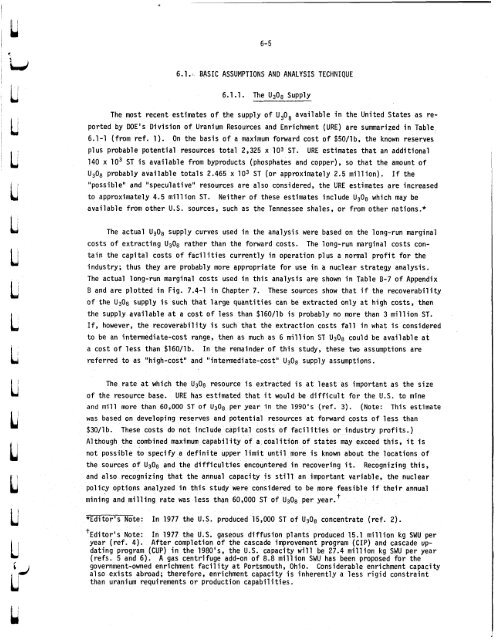ORNL-5388 - the Molten Salt Energy Technologies Web Site
ORNL-5388 - the Molten Salt Energy Technologies Web Site
ORNL-5388 - the Molten Salt Energy Technologies Web Site
Create successful ePaper yourself
Turn your PDF publications into a flip-book with our unique Google optimized e-Paper software.
id<br />
1<br />
8;<br />
L<br />
L<br />
t<br />
B<br />
hi<br />
li<br />
6-5<br />
6.1 .. BASIC ASSUMPTIONS AND ANALYSIS TECHNIQUE<br />
6.1.1. The U308 Supply<br />
The most recent estimates of <strong>the</strong> supply of U308 available in <strong>the</strong> United States as re-<br />
ported by DOE'S Division of Uranium Resources and Enrichment (URE) are summarized in Table<br />
6.1-1 (from ref. 1). On <strong>the</strong> basis of a maximum forward cost of $50/lb, <strong>the</strong> known reserves<br />
plus probable potential resources total 2,325 x 103 ST. URE estimates that an additional<br />
140 x lo3 ST is available from byproducts (phosphates and copper), so that <strong>the</strong> amount of<br />
U308 probably available totals 2.465 x lo3 ST (or approximately 2.5 million). If <strong>the</strong><br />
"possible" and "speculative" resources are also considered, <strong>the</strong> URE estimates are increased<br />
to approximately 4.5 million ST. Nei<strong>the</strong>r of <strong>the</strong>se estimates include U308 which may be<br />
available from o<strong>the</strong>r U.S. sources, such as <strong>the</strong> Tennessee shales, or from o<strong>the</strong>r nations.*<br />
The actual U3O8 supply curves used in <strong>the</strong> analysis were based on <strong>the</strong> long-run marginal<br />
costs of extracting U308 ra<strong>the</strong>r than <strong>the</strong> forward costs. The long-run marginal costs con-<br />
tain <strong>the</strong> capital costs of facilities currently in operation plus a normal profit for <strong>the</strong><br />
industry; thus <strong>the</strong>y are probably more appropriate for use in a nuclear strategy analysis.<br />
The actual long-run marginal costs used in this analysis are shown in Table 6-7 of Appendix<br />
B and are plotted in Fig. 7.4-1 in Chapter 7. These sources show that if <strong>the</strong> recoverability<br />
of <strong>the</strong> U3O8 supply is such that large quantities can be extracted only at high costs, <strong>the</strong>n<br />
<strong>the</strong> supply available at a cost of less than $160/lb is probably no more than 3 million ST.<br />
If, however, <strong>the</strong> recoverability is such that <strong>the</strong> extraction costs fall in what is considered<br />
to be an intermediate-cost range, <strong>the</strong>n as much as 6 million ST U3O8 could be available at<br />
a cost of less than $160/lb.<br />
In <strong>the</strong> remainder of this study, <strong>the</strong>se two assumptions are<br />
referred to as "high-cost" and "intermediate-cost" U3O8 supply assumptions.<br />
The rate at which <strong>the</strong> U3O8 resource is extracted is at least as important as <strong>the</strong> size<br />
of <strong>the</strong> resource base. URE has estimated that it would be difficult for <strong>the</strong> U.S. to mine<br />
and mill more than 60,000 ST of U3O8 per year in <strong>the</strong> 1990's (ref. 3). (Note: This estimate<br />
was based on developing reserves and potential resources at forward costs of less than<br />
$30/lb.<br />
These costs do not include capital costs of facilities or industry profits.)<br />
Although <strong>the</strong> combined maximum capability of a coalition of states may exceed this, it is<br />
not possible to specify a definite upper limit until more is known about <strong>the</strong> locations of<br />
<strong>the</strong> sources of U3O8 and <strong>the</strong> difficulties encountered in recovering it. Recognizing this,<br />
and also recognizing that <strong>the</strong> annual capacity is still an important variable, <strong>the</strong> nuclear<br />
policy options analyzed in this study were considered to be more feasible if <strong>the</strong>ir annual<br />
mining and milling rate was less than 60,000 ST<br />
t<br />
of U3O8 per year.<br />
*Editor's Note: In 1977 <strong>the</strong> U.S. produced 15,000 ST of U3O8 concentrate (ref. 2).<br />
'Editor's Note: In 1977 <strong>the</strong> U.S. gaseous diffusion plants produced 15.1 million kg SWU per<br />
year (ref. 4). After completion of <strong>the</strong> cascade improvement program (CIP) and cascade updating<br />
program (CUP) in <strong>the</strong> 1980'~~ <strong>the</strong> U.S. capacity will be 27.4 million kg SWU per year<br />
(refs. 5 and 6). A gas centrifuge add-on of 8.8 million SWU has been proposed for <strong>the</strong><br />
government-owned enrichment facility at Portsmouth, Ohio. Considerable enrichment capacity<br />
a1 so exists abroad; <strong>the</strong>refore, enrichment capacity is inherently a less rigid constraint<br />
than uranium requirements or production capabilities.



![Review of Molten Salt Reactor Physics Calculations [Disc 2]](https://img.yumpu.com/21979492/1/190x247/review-of-molten-salt-reactor-physics-calculations-disc-2.jpg?quality=85)












